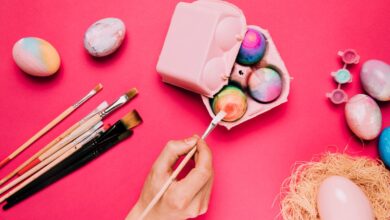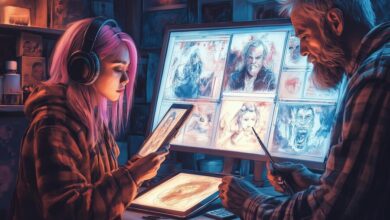Discover the Essence of Figurative Design in Graphic Art

Figurative design is more than a trend; it’s a timeless element that breathes life and emotion into visual storytelling. Whether you’re a seasoned graphic designer, an aspiring artist, or simply a design enthusiast, understanding the power of figurative design can significantly enhance your creative repertoire.
In this blog post, we will explore everything you need to know about figurative design. From its historical roots to its modern-day applications, we’ll uncover the techniques, tools, and cultural significance that make figurative design a staple in the world of graphic art.
Introduction to Figurative Design
Defining Figurative Design
Figurative design refers to artistic compositions that represent real-world objects, people, and scenes. Unlike abstract art, which breaks away from reality, figurative design leans into it, offering a recognizable form that resonates with viewers. This design approach can be found in various mediums, from digital illustrations to traditional paintings.
The Role of Figurative Design in Graphic Art
Figurative design plays a crucial role in graphic art by providing clarity and relatability. It allows artists to convey complex ideas through familiar visuals, making the artwork more accessible and engaging. For graphic designers, incorporating figurative elements can enhance branding, marketing materials, and even user interface designs, ensuring the message is both impactful and memorable.
Why Figurative Design Matters
Figurative design is not just about aesthetics; it’s about connection. By drawing on the familiarity of real-world imagery, this design style bridges the gap between the artist and the audience. Whether it’s a logo that captures the essence of a brand or an illustration that tells a story, figurative design adds depth and authenticity to any project.
The History of Figurative Design
Early Beginnings
The roots of figurative design can be traced back to prehistoric cave paintings, where early humans depicted animals and hunting scenes. These early artworks were not only a means of communication but also a way to document and celebrate life.
Evolution Through the Ages
Figurative design continued to evolve through the ages, influenced by cultural, social, and technological changes. During the Renaissance, artists like Leonardo da Vinci and Michelangelo perfected the art of realism, creating lifelike representations that are still revered today. The 20th century saw a blend of realism and abstraction, with artists experimenting with new forms and styles while maintaining a connection to the tangible world.
Cultural Significance
Figurative design holds significant cultural value, reflecting the beliefs, values, and experiences of different societies. From the detailed tapestries of medieval Europe to the intricate woodblock prints of Japan, each culture has its unique take on figurative design, enriching the global art landscape.
Figurative Design in Modern Art
Contemporary Artists and Their Works
Today’s artists are pushing the boundaries of figurative design, blending traditional techniques with modern technology. Artists like Kehinde Wiley and Jenny Saville are known for their strikingly realistic portraits that challenge social norms and provoke thought. Their work is a testament to the enduring power of figurative design in contemporary art.
Integration with Digital Media
The advent of digital media has opened new avenues for figurative design. Graphic designers now have access to advanced software and tools that allow for greater precision and creativity. Digital illustrations, 3D modeling, and augmented reality are just a few examples of how modern technology is transforming figurative design.
Trends and Innovations
Modern art is continually evolving, and figurative design is no exception. Current trends include hyperrealism, where artists create incredibly detailed and lifelike images, and surrealism, which blends reality with fantasy. These trends showcase the versatility of figurative design and its ability to adapt to different artistic visions.

Techniques and Tools for Figurative Design
Traditional Techniques
Mastering figurative design begins with understanding traditional techniques. Drawing from life, mastering anatomy, and studying light and shadow are essential skills for any artist. Techniques like cross-hatching, stippling, and blending can add texture and depth to your figurative designs.
Digital Tools
In the digital age, a plethora of tools are available to aid in creating stunning figurative designs. Software like Adobe Illustrator and Photoshop offer a range of features for illustration, while programs like Blender and ZBrush are perfect for 3D modeling. These tools not only streamline the design process but also provide endless possibilities for creativity.
Practical Tips for Beginners
For those new to figurative design, start with the basics. Practice sketching from real life, study the work of master artists, and experiment with different mediums. Leverage digital tools to refine your skills and explore new techniques. Remember, the key to mastering figurative design is continuous practice and exploration.
Figurative Design in Branding and Marketing
The Power of Visual Storytelling
In branding and marketing, figurative design is a powerful tool for visual storytelling. It helps create a narrative that resonates with the audience, making the brand more relatable and memorable. From logos to advertisements, figurative elements can convey emotions and messages that words alone cannot.
Case Studies of Successful Campaigns
Consider the Coca-Cola “Share a Coke” campaign, which featured personalized labels with people’s names. This simple yet effective use of figurative design created a personal connection with consumers, driving sales and brand loyalty. Another example is Nike’s “Just Do It” campaign, where dynamic, figurative imagery of athletes in action reinforced the brand’s message of empowerment and determination.
Creating Emotional Connections
Figurative design has the unique ability to evoke emotions. By depicting relatable scenarios and characters, brands can create deeper connections with their audience. Whether it’s through a heartfelt illustration or a powerful visual narrative, figurative design can make a lasting impact.
Conclusion
Figurative design is a versatile and powerful element in graphic art, offering endless possibilities for creativity and expression. By understanding its history, techniques, and modern applications, you can harness its potential to create engaging and impactful designs.
Whether you’re a graphic designer, an aspiring artist, or a design enthusiast, incorporating figurative design into your work can elevate your projects and connect with your audience on a deeper level. Explore the world of figurative design, experiment with different techniques, and see how this timeless art form can transform your creative endeavors.
Ready to take your figurative design skills to the next level? Join our community of artists and designers for exclusive tips, tutorials, and inspiration. Together, we can explore the endless possibilities of figurative design.



